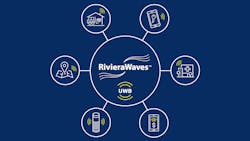Low-Power UWB IP Meets Needs of IoT, Consumer Apps
Having already rolled out turnkey IP solutions for wireless IoT applications using Wi-Fi, Bluetooth, Cellular-IoT, and GNSS, CEVA has turned its attention to ultra-wideband (UWB) technology. The company has debuted its RivieraWaves UWB platform, comprising extremely power-efficient, ultra-wideband (UWB) turnkey MAC and PHY intellectual property (IP) that’s compliant with the IEEE 802.15.4z standard and in accordance with the FiRa Consortium’s specifications.
The RivieraWaves UWB platform IP delivers secure, centimeter-level accuracy and robust location information through Time-of-Flight (ToF) ranging and Angle-of-Arrival (AoA) processing. The new RivieraWaves UWB platform IP is ideal for a broad range of ultra-low-power applications and products such as tags for pinpoint asset finding, secure digital key functionality for door locks, real-time location services (RTLS), and payment systems. UWB isn’t new, nor has it had a history of broad market success. But of late, it’s seeing a resurgence thanks to its adoption in leading smartphone brands. CEVA is betting its new platform will lower the entry barrier and accelerate time-to-market for semiconductor and IoT companies looking to develop UWB-enabled devices.
The IP consists of a power-optimized hardware PHY along with a flexible, low-latency hardware and software MAC layer. The MAC layer software can be implemented on the CEVA-BX1 DSP when deployed in combination with other connectivity workloads or modes such as direction finding, localization, or radar, or as a standalone UWB MAC on commercial Arm and RISC-V MCUs. A flexible radio interface enables the RivieraWaves UWB platform IP to be deployed with customers’ own RF technology or with CEVA partners’ RF IP. Furthermore, RivieraWaves UWB platform IP is designed for ultra-low-power use cases, offering high performance and cost efficiency, particularly when combined with RivieraWaves Bluetooth IP. This combined IP offering is claimed as an industry first and addresses emerging applications and use cases that leverage both standards.
Below are some key features of CEVA’s RivieraWaves UWB platform IP:
- MAC and PHY with support of enhanced ranging and security based on IEEE 802.15.4z HRP in accordance with the FiRa Consortium requirements
- Low-power hardware PHY, implementing a highly sensitive coherent receiver with power-optimized synchronization, supporting centimeter-level accuracy ranging and AoA estimation based on multiple antennas
- Portable MAC-layer software, with hardware offloading for encryption/authentication (CCM AES) and key management, autonomous ACK handshaking and other real-time critical operations
- Flexible low-power modes applicable to FiRa ranging scenarios
- FiRa standard UWB Command Interface (UCI) simplifies the interface to the application-level software
- Flexible digital radio interface, designed to accommodate various radios
- Available as a standalone UWB IP or in combination with RivieraWaves Bluetooth platform IP
RivieraWaves UWB is available for licensing now. For more information, visit https://www.ceva-dsp.com/product/rivierawaves-uwb-platform/
About the Author
David Maliniak
Executive Editor, Microwaves & RF
I am Executive Editor of Microwaves & RF, an all-digital publication that broadly covers all aspects of wireless communications. More particularly, we're keeping a close eye on technologies in the consumer-oriented 5G, 6G, IoT, M2M, and V2X markets, in which much of the wireless market's growth will occur in this decade and beyond. I work with a great team of editors to provide engineers, developers, and technical managers with interesting and useful articles and videos on a regular basis. Check out our free newsletters to see the latest content.
You can send press releases for new products for possible coverage on the website. I am also interested in receiving contributed articles for publishing on our website. Use our contributor's packet, in which you'll find an article template and lots more useful information on how to properly prepare content for us, and send to me along with a signed release form.
About me:
In his long career in the B2B electronics-industry media, David Maliniak has held editorial roles as both generalist and specialist. As Components Editor and, later, as Editor in Chief of EE Product News, David gained breadth of experience in covering the industry at large. In serving as EDA/Test and Measurement Technology Editor at Electronic Design, he developed deep insight into those complex areas of technology. Most recently, David worked in technical marketing communications at Teledyne LeCroy, leaving to rejoin the EOEM B2B publishing world in January 2020. David earned a B.A. in journalism at New York University.

